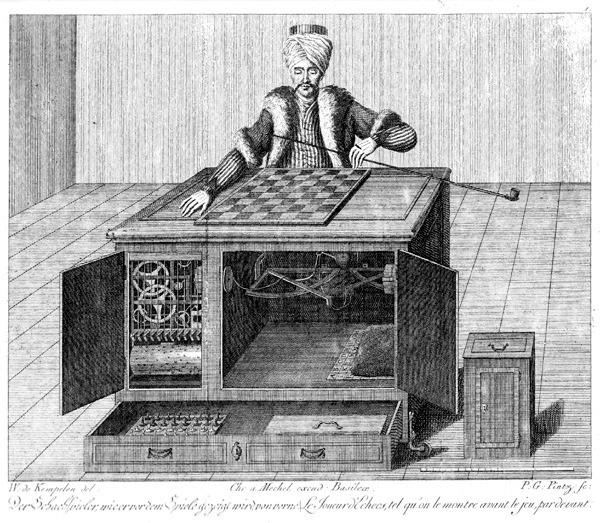In the history of chess, few stories are as captivating and shrouded in mystery as that of the Turk chess automaton. Unveiled in 1770 by Wolfgang von Kempelen, a Hungarian inventor and engineer, the Turk stunned audiences across Europe and America for nearly 85 years with its seemingly incredible ability to play chess against and often defeat human opponents, including prominent figures and seasoned chess masters. This mechanical marvel, cloaked in an air of mystery, was a life-sized figure dressed in Ottoman attire, seated behind a large wooden cabinet and impressively maneuvering chess pieces across the board with a dexterous hand.
The Turk’s fame was not merely due to its chess-playing prowess; it was also a symbol of the era’s fascination with automata and the boundaries between man, machine, and magic. This article delves into the intriguing story of the Turk chess automaton, exploring its historical context, mechanical workings, and the enduring legacy it left in the worlds of technology, chess, and the broader cultural imagination.
What is The Turk?

The Turk chess automaton, a creation of the 18th century, stands as a fascinating chapter in the history of mechanical inventions. Conceived and built by Wolfgang von Kempelen, a Hungarian author, in 1770, the Turk was an ingenious blend of art and machinery, a figure that captured the imagination of its time and continues to intrigue us today.
Design and Appearance
The Turk was a life-sized figure dressed in exotic Ottoman garb, seated behind a large cabinet. This cabinet, measuring about four feet long, two feet deep, and three feet high, was essential to the Turk’s operation. The figure itself held a long pipe in its left hand, while its right hand was used to move the chess pieces across the board. The Turk’s appearance was designed to be striking and mysterious, evoking the allure of the Orient, which was a subject of much fascination in Europe at the time.
Mechanical Ingenuity
Kempelen’s creation was hailed as a mechanical marvel. The cabinet contained a complex arrangement of gears, levers, and cogs, suggesting the workings of an automated machine capable of playing chess. Upon presentation, Kempelen would open various doors of the cabinet to show the audience the intricate machinery inside, ostensibly to prove that there was no human operator. The Turk was capable of making moves on its own, nodding three times to indicate check and shaking its head when an illegal move was made, adding to the illusion of intelligence.
Chess-Playing Capabilities
The Turk was not only an automaton but also a capable chess player. It played—and often won—against a variety of opponents, from amateurs to experienced chess masters. This level of skill further fueled speculation and fascination about how the machine could possibly operate without human intervention.
The Enigma of Operation
For decades, the true nature of the Turk’s operation remained a closely guarded secret, leading to widespread speculation and theories. Some believed it was controlled by a hidden operator, while others speculated about the possibility of advanced mechanics or even early forms of computing. The Turk’s design cleverly concealed any signs of human intervention, making it one of the most successful hoaxes of its time.
Did the Turk Chess Automaton Actually Work?
One of the most enduring questions surrounding the Turk chess automaton is whether it was a genuine example of an early computer or an elaborate deception. After decades of speculation and investigation, the truth about the Turk has been uncovered, revealing a masterful blend of illusion and mechanical engineering.
The Ingenious Deception
Contrary to the beliefs held by many during its era of operation, the Turk was not an autonomous machine. The secret to its chess-playing prowess was not in advanced machinery or early computation but in human intelligence. Inside the seemingly cramped cabinet, there was a specially designed hiding space that could accommodate a human chess master. This hidden operator, concealed by the intricate arrangement of gears and levers visible to the public, was the true source of the Turk’s intelligence.
The Art of Concealment
Wolfgang von Kempelen, the inventor, designed the Turk’s cabinet with a series of sliding panels and a movable seat, allowing the operator inside to remain hidden even when doors were opened for inspection. The operator inside could view the chessboard through a system of magnets and strings that indicated the opponent’s moves and then manipulate the Turk’s arm and hand to make its own moves.
Public Perception and Revelation
For over 85 years, the Turk traveled across Europe and America, fascinating audiences with its seemingly miraculous ability to play chess. The mystery of its operation fueled its popularity, with many speculating about the presence of a hidden operator, while others marveled at the possibility of a true machine intelligence. It wasn’t until the destruction of the Turk in a fire in 1854 and subsequent investigations by historians and scholars that the reality of its operation was fully disclosed.
The revelation that the Turk was an elaborate hoax did not diminish its significance in the history of technology and entertainment. Instead, it underscored the ingenuity involved in its creation and the impact it had on public perceptions of automation and artificial intelligence. The Turk served as an inspiration for future generations of inventors and played a pivotal role in the early discussions about the potential and limits of machine intelligence.
Conclusion
The Turk chess automaton stands as a remarkable chapter in the history of chess, embodying the intricate interplay between artifice and ingenuity. Wolfgang von Kempelen’s creation, though eventually unveiled as an elaborate illusion, captivated audiences for nearly a century, challenging their perceptions of machine intelligence and automation.